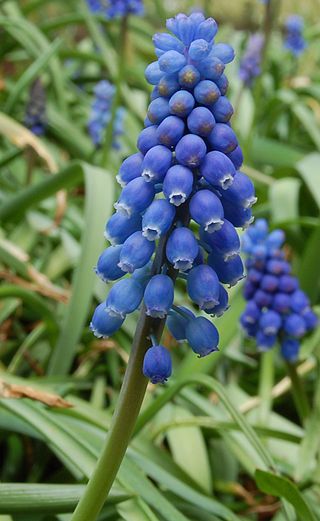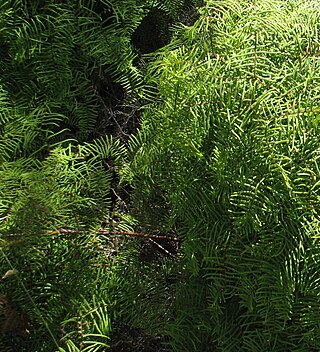
The Percolozoa are a group of colourless, non-photosynthetic Excavata, including many that can transform between amoeboid, flagellate, and cyst stages.

In botany, a drupe is an indehiscent fruit in which an outer fleshy part surrounds a single shell of hardened endocarp with a seed (kernel) inside. These fruits usually develop from a single carpel, and mostly from flowers with superior ovaries.
Virus classification is the process of naming viruses and placing them into a taxonomic system similar to the classification systems used for cellular organisms.

Uropygi is an arachnid order comprising invertebrates commonly known as whip scorpions or vinegaroons. They are often called uropygids. The name "whip scorpion" refers to their resemblance to true scorpions and possession of a whiplike tail, and "vinegaroon" refers to their ability when attacked to discharge an offensive, vinegar-smelling liquid, which contains acetic acid. The order may also be called Thelyphonida. Both names, Uropygi and Thelyphonida, may be used either in a narrow sense for the order of whip scorpions, or in a broad sense which includes the order Schizomida. For clarity, sensu stricto or s.s. may be added to specify the narrow sense, and sensu lato or s.l. added to specify the broad sense. When these additions are omitted, the names Uropygi and Thelyphonida are ambiguous.

Kookaburras are terrestrial tree kingfishers of the genus Dacelo native to Australia and New Guinea, which grow to between 28 and 47 cm in length and weigh around 300 g (11 oz). The name is a loanword from Wiradjuri guuguubarra, onomatopoeic of its call. The loud, distinctive call of the laughing kookaburra is widely used as a stock sound effect in situations that involve an Australian bush setting or tropical jungle, especially in older movies.

Juncaceae is a family of flowering plants, commonly known as the rush family. It consists of 8 genera and about 464 known species of slow-growing, rhizomatous, herbaceous monocotyledonous plants that may superficially resemble grasses and sedges. They often grow on infertile soils in a wide range of moisture conditions. The best-known and largest genus is Juncus. Most of the Juncus species grow exclusively in wetland habitats. A few rushes, such as Juncus bufonius are annuals, but most are perennials.

Protopterus is the genus of four species of lungfish found in Africa. Protopterus is considered the sole genus in the family Protopteridae, which is sometimes grouped with Lepidosiren in the family Lepidosirenidae.

Muscari is a genus of perennial bulbous plants native to Eurasia that produce spikes of dense, most commonly blue, urn-shaped flowers resembling bunches of grapes in the spring. The common name for the genus is grape hyacinth, but they should not be confused with hyacinths. A number of species of Muscari are used as ornamental garden plants.

Gravitholus was a genus of pachycephalosaurid dinosaur from the late Cretaceous period. It was a pachycephalosaur, and like other pachycephalosaurids the skull roof formed a thick dome made of dense bone, which may have been used in head-butting contests over mates or territory. It lived in what is now Alberta, Canada, and was described in 1979 by W. P. Wall and Peter Galton. The type species is Gravitholus albertae.

Calosoma is a genus of large ground beetles that occur primarily throughout the Northern Hemisphere, and are referred to as caterpillar hunters or caterpillar searchers. Many of the 167 species are largely or entirely black, but some have bright metallic coloration. They produce a foul-smelling spray from glands near the tip of the abdomen. They are recognizable due to their large thorax, which is almost the size of their abdomen and much wider than their head.

Gleichenia is a genus of ferns. Its closest relative is the genus Stromatopteris, restricted to New Caledonia.

Nebria is a genus of ground beetles native to the Palearctic, the Near East and North Africa. There are more than 500 described species in Nebria.

Carabinae is a subfamily of ground beetles in the family Carabidae. There are about 10 genera and more than 1,400 described species in Carabinae.
Paraperipatus is a genus of velvet worms in the family Peripatopsidae. The number of legs vary within species as well as among species in this genus and can range from as few as 21 pairs up to 27 pairs in males and 29 pairs in females. The maximum number of leg pairs recorded in this genus (29) is also the maximum number of leg pairs found in the family Peripatopsidae. This genus exhibits matrotrophic viviparity, that is, mothers in this genus retain eggs in their uteri and supply nourishment to their embryos, but without any placenta. Species in this genus are found in New Guinea and Maluku, Indonesia.
Ultimate Fighting Championship rankings, which were introduced in February 2013, are generated by a voting panel made up of media members. These media members are asked to vote for whom they feel are the top fighters in the UFC by weight class and pound-for-pound. A fighter is only eligible to be voted on if they are of active status in the UFC. A fighter can appear in more than one weight division at a time. The champion and interim champion are considered to be in top positions of their respective divisions and therefore are not eligible for voting by weight class. However, the champions can be voted on for the pound-for-pound rankings.

Kansaignathus is a genus of velociraptorine dromaeosaurid from the Late Cretaceous Ialovachsk Formation of Tajikistan. The genus contains a single species, Kansaignathus sogdianus.

UFC 286: Edwards vs. Usman 3 was a mixed martial arts event produced by the Ultimate Fighting Championship that took place on March 18, 2023, at The O2 Arena in London, England.

UFC Fight Night: Yan vs. Dvalishvili was a mixed martial arts event produced by the Ultimate Fighting Championship that took place on March 11, 2023, at The Theater at Virgin Hotels in Paradise, Nevada part of the Las Vegas Metropolitan Area, United States.

Migadopini is a tribe of ground beetles in the family Carabidae. There are about 16 genera and more than 40 described species in Migadopini.















